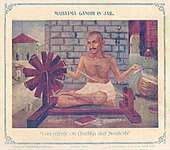Swadeshi movement
The Swadeshi movement, part of the Indian independence movement and the developing Indian nationalism five phases of the Swadeshi movement.[1]

The Swadeshi movement started with the partition of Bengal by the Viceroy of India, Lord Curzon in 1905 and continued up to 1911. It was the most successful of the pre-Gandhian movements. Its chief architects were Aurobindo Ghosh, Lokmanya Bal Gangadhar Tilak, Bipin Chandra Pal and Lala Lajpat Rai, V. O. Chidambaram Pillai, Babu Genu. Swadeshi, as a strategy, was a key focus of Mahatma Gandhi, who described it as the soul of Swaraj (self rule). It was strongest in Bengal and was also called the Vandemataram movement in India.
Background
Etymology
The word Swadeshi derives from Sanskrit and is a sandhi or conjunction of two Sanskrit words. Swa means "self" or "own" and desh means country, so Swadesh would be "own country", and Swadeshi, the adjectival form, would mean "of one's own country".
History
Credit to starting the Swadeshi movement goes to Baba Ram Singh Kuka of the Sikh Namdhari sect,[2] whose revolutionary movements which heightened around 1871 and 1872.[3] Naamdharis were instructed by Baba Ram Singh to only wear clothes made in the country and boycott foreign goods.[4] The Namdharis resolved conflict in the peoples court and totally avoided British law and British courts. They also boycotted the educational system as Baba Ram Singh prohibited children from attending British School, amongst other forms and measures he employed.[5]
- 1850 to 1904: developed by leaders like Dadabhai Naoroji, Gokhale, Ranade, Tilak, G. V. Joshi and Bhaswat K. Nigoni. This was also known as First Swadeshi Movement.
- 1905 to 1917: Began in 1905, because of the partition of Bengal ordered by Lord Curzon.
- 1918 to 1947: Swadeshi thought shaped by Gandhi, accompanied by the rise of Indian91: Widespread curbs on international andion of obsolete technology during the licence-permit raj.
- 1991 onwards: liberalization privatisation and globalization. Foreign capital, foreign technology, and many foreign goods are not excluded and doctrine of export-led growth resulted in modern industrialism.
Legacy and influences
In popular media
- E. F. Schumacher, author of Small Is Beautiful, was influenced by Gandhi's concept of Swadeshi when he wrote his article on Buddhist economics[6]
- Satish Kumar, editor of Resurgence, has preaching, including a section in his book You Are, Therefore I Am (2002).
Swadeshi after independence
The Post-Independence "Swadeshi Movement" has developed forth differently than its pre-independence counterpart. While the pre-independence movement was essentially a response to colonial policies, the post-independence Swadeshi movement sprung forth as an answer to increasingly oppressive imperialistic policies in the post-Second World War climate. For a nation emerging from two centuries of colonial oppression, India was required to compete with the industrialised economies of the west. While rapid industrialisation under the umbrella of "Five year Plans" were aimed at enabling a self-sufficient India, the need to balance it with a predominantly agrarian set-up was the need of the hour. This need to preserve the old fabric of an agrarian country while simultaneously modernising, necessitated a resurgence of a slightly recast "Swadeshi Movement". Forerunners of this resurgent movement was noted journalist, writer and critic S. R. Ramaswamy. Others of late in the movement include the likes of Rajiv Dixit, Swami Ramdev and Pawan Pandit. In the Digital World Swadeshishopping.com taking novel initiative for promoting Swadeshi Movement.[7][8]
National Handloom Day
On 7 August 2015, Prime Minister of India, Narendra Modi, instituted and celebrated first annual "National Handloom Day of India" to promote indigenous handloom and khadi products. The date was chosen as on this date in 1905 that proclamation was made to commence Swadeshi movement to boycott foreign goods and use only Indian-made products.[9]
See also
- Related independence topics
- Legacy and impact
- Khadi
- Khadi and Village Industries Commission
- Make In India
- National Charkha Museum
- Rajiv Dixit
- Standup India
- Startup India
- Swadeshi Jagaran Manch
- General topics
- Autarky – A country, state, or society which is economically independent.
- Juche – The North Korean philosophy of self-reliance.
- Self-determination
References
- [L. M. Bhole, Essays on Gandhian Socio-Econic, Shipra Publications, Delhi, 2000. Chapter 14: Swadeshi: Meaning and Contemporary Relevance]
- Anjan, Tara; Rattan, Saldi (2016). Satguru Ram Singh and the Kuka Movement. New Delhi: Publications Division Ministry of Information & Broadcasting. ISBN 9788123022581.
- McLeod, W. H.; French, Louis (2014). Historical Dictionary of Sikhism. Rowman & Littlefield. p. 261. ISBN 9781442236011.
- Clarke, Peter (2004). Encyclopedia of New Religious Movements. Oxon: Routledge. p. 425. ISBN 9781134499700.
- Kaur, Manmohan (1985). Women in India's freedom struggle. Sterling. p. 76.
- Weber, Thomas (May 1999). "Gandhi, Deep Ecology, Peace Research and Buddhist Economics". Journal of Peace Research. 36 (3): 349–361. doi:10.1177/0022343399036003007.
- MINISTRY of AYUSH Letter-https://drive.google.com/open?id=0B-AY8yyuVlsOWWdkVEQ3Nmx3R0E
- Swadeshi Movement. "The Third Swadeshi Abhiyan Started in 20th century and the movement is continues. the main faces of the movement". Swadeshi Movement. Retrieved August 15, 2009.
- Explained: Why is August 7 called National Handloom Day, Indian Express, 7 August 2020.
Further reading
- Bandyopadhyay, Sekhar. From Plassey to Partition - A History of Modern India (2004) pp 248–62
- Das, M. N. India Under Morley and Minto: Politics Behind Revolution, Revolution and Reform (1964)
- Gonsalves, Peter. Clothing for Liberation, A Communication Analysis of Gandhi's Swadeshi Revolution, SAGE, (2010)
- Gonsalves, Peter. Khadi: Gandhi's Mega Symbol of Subversion, SAGE, (2012)
- Trivedi, Lisa. "Clothing Gandhi's Nation: Homespun and Modern India", Indiana University Press, (2007)
- Trivedi, Lisa N. (February 2003). "Visually Mapping the 'Nation': Swadeshi Politics in Nationalist India, 1920-1930". The Journal of Asian Studies. Association for Asian Studies. 62 (1): 11–41. doi:10.2307/3096134. JSTOR 3096134.
| Look up swadeshi in Wiktionary, the free dictionary. |